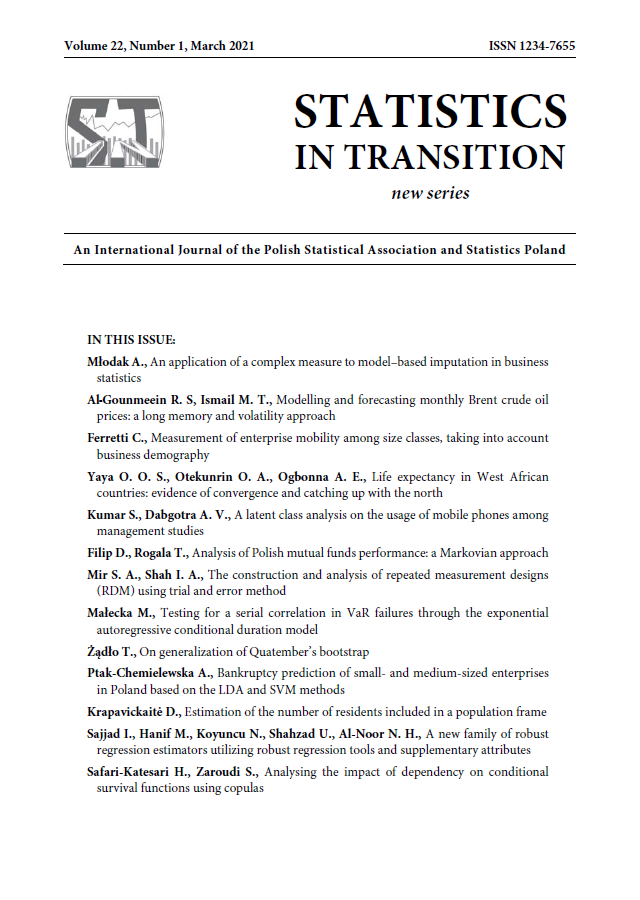ARTICLE
ABSTRACT
The article aims to investigate the possibility of the convergence and catching up of life expectancy values observed in West African countries with those noted in North African countries. Following the theory of time series convergence, documented in Bernard and Durlauf (1996) and Greasley and Oxley (1997), more robust unit root tests, based on the Fourier nonlinearity and instantaneous breaks proposed in Furuoka (2017), are used in investigating the convergence of each pair of a West African country and its North African counterpart. As no unit root in the differences of the pairs implies convergence, the results obtained by means of the new statistical approach quite outperform those produced by classical unit root tests. The results provide general evidence of the convergence of life expectancy values recorded in West Africa and North Africa.
KEYWORDS
Africa, convergence, Fourier function, life expectancy ratio, nonlinearity, unit root
REFERENCES
ABORIGINAL AND TORRES STRAIT ISLANDER HEALTH PERFORMANCE FRAMEWORK (HPF), (2012). Tier 1- Life expectancy and wellbeing, Available Online: https://www.health.gov.au, Accessed on March 2, 2019.
BARTHOLD JONES, J.A., LENART, A. and BAUDISCH, A., (2018). The complexity of the relationship between life expectancy and overlap of lifespans, PLoS ONE 13(7), e0197985, https://doi.org/10.1371/journal.pone.0197985.
BERNARD, A. B., DURLAUF, S. N., (1996). Interpreting tests of the convergence hypothesis. Journal of Econometrics, 71, pp. 161–173.
CUNADO, J., PÉREZ DE GRACIA, F., (2006). Real convergence in Africa in the second-half of the 20th century. Journal of Economics and Business, 58(2), pp. 153–167, doi:10.1016/j.jeconbus.2005.07.002.
DICKEY, D. A., FULLER, W. A., (1979). Distribution of the Estimators for Autoregressive Time Series with a Unit Root. Journal of the American Statistical Association, 74, pp. 427–431.
ENDERS, W., LEE, J., (2012a). A unit root test using a Fourier series to approximate smooth breaks. Oxford Bulleting of Economics and Statistics, 74, pp. 574–599.
ENDERS, W., LEE, J., (2012b). The flexible Fourier form and Dickey-Fuller-type unit root tests. Economic Letters, 117, pp. 196–199.
FURUOKA, F., (2017). A new approach to testing unemployment hysteresis. Empirical Economics, 53(3), pp. 1253–1280.
GREASLY, D., OXLEY, S., (1997). Time-series based tests of the convergence hypothesis: Some positive results. Economic Letters, 56, pp. 143–147.
KONTIS, V., BENNETT, J. E., MATHERS, C. D., LI, G., FOREMAN, K. and EZZATI, M., (2017). Future life expectancy in 35 industrialised countries: projections with a Bayesian model ensemble, Lancet, 389(10076), pp. 1323–1335, DOI: 10.1016/S0140-6736(16)32381-9.
MONDAL, N. I., SHITAN, M., (2013). Impact of Socio-Health Factors on Life Expectancy in the Low and Lower Middle Income Countries. Iranian Journal of Public Health, 42(12), pp. 1354–1362.
NMETH, L., MISSOV, T. I., (2018). Adequate life-expectancy reconstruction for adult human mortality data, PLoS ONE 13(6), e0198485, https://doi.org/10.1371/journal.pone.0198485.
NKALU, C. N., EDEME, R. K., (2019). Environmental Hazards and Life Expectancy in Africa: Evidence from GARCH Model, SAGE Open pp. 1–8, DOI: 10.1177/2158244019830500.
ORTIZ-OSPINA, ESTEBAN, (2017). “Life expectancy”- What does this actually mean? Our World in Data, Available Online: https://ourworldindata.org, Accessed on March 2, 2019.
OTEKUNRIN, O. A., OTEKUNRIN, O. A., MOMOH, S. and AYINDE, I. A., (2019a). How far has Africa gone in achieving the zero hunger target? Evidence from Nigeria. Global Food Security 22, pp. 1–12, https://doi.org/10.1016/j.gfs.2019.08.001.
OTEKUNRIN, O. A., MOMOH, S., AYINDE, I. A. and OTEKUNRIN, O. A., (2019b). How far has Africa gone in achieving sustainable development goals? Exploring African dataset, Data in Brief 27:104647, https://doi.org/10.1016/j.gfs.2019.08.001.
PASCARIU, M. D., CANUDAS-ROMO, V. and VAUPEL J. W., (2018). The doublegap life expectancy forecasting model. Insurance: Mathematics and Economics 78, pp. 339–350, https://doi.org/10.1016/j.insmatheco.2017.09.011.
PERRON, P., VOGELSANG, T. J., (1992). Non-stationarity and level shifts with an application to purchasing power parity. Journal of Business, Economics and Statistics, 10(3), pp. 301–320.
STATISTICA, (2018). Life Expectancy in Europe, Available Online: www.statista.com, Accessed March 2, 2019.
STATISTICA, (2018). Life Expectancy in Africa, Available Online: www.statista.com, Accessed June 22, 2020.
STEVENS, E. R., ZHOU, Q., TAKSLER, G. B., NUCIFORA, K. A., GOUREVITCH, M. and BRAITHWAITE, R. S., (2019). An alternative mathematical modeling approach to estimating a reference life expectancy. MDM Policy & Practice, pp. 1–12, DOI: 10.1177/2381468318814769.
UCHENDU, F. N., (2018). Hunger influenced life expectancy in war-torn Sub-Saharan African countries. Journal of Health, Population and Nutrition 37, 11, https://doi.org/10.1186/s41043-018-0143-3.
UNITED NATIONS. DEPARTMENT OF ECONOMIC AND SOCIAL AFFAIRS, POPULATION DIVISION, (2019). World Mortality 2019: Data Booklet (ST/ ESA/SER.A/436), https://www.un.org/en/development/desa/population/publications/pdf/mortality/ WMR2019/WorldMortality2019DataBooklet.pdf.
VAN BAAL, P., PETERS, F., MACKENBACH, J., and NUSSELDER, W., (2016).Forecasting differences in life expectancy by education. Population Studies, 70(2), pp. 201–216, DOI: 10.1080/00324728.2016.1159718
WIYSONGE, C. S. (2018). People are living longer in Africa but the rise of lifestyle diseases threatens progress. Quartz Africa, https://qz.com/africa/1475911/, Accessed June 22, 2020.
WORLD POPULATION REVIEW: LIFE EXPECTANCY BY COUNTRY 2017. Available Online: worldpopulationreview.com, Accessed on March 2, 2019.
YAYA, O. S., OGBONNA, A. E. and ATOI, N. V., (2019). Are inflation rates in OECD countries actually stationary during 2011–2018? Evidence based on Fourier Nonlinear Unit root tests with Break, The Empirical Economics Review, 9(4), pp. 309–325.
YAYA, O.S., OGBONNA, A.E. and MUDIDA, R., (2019). Hysteresis of Unemployment rate in Africa: New Findings from Fourier ADF test. Quality and Quantity International Journal of Methodology, 53(6), pp 2781–2795.
